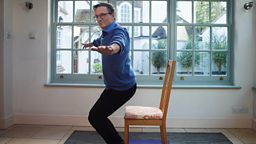Building body strength might be easier than you think
You might think you need to lift heavy weights to build muscle. But, it's when you're lowering the weight that the real magic happens. It's called Eccentric Exercise, and it's the secret workout that’s been hiding in your routine all along.
Focusing on lengthening and extending the muscle is one of the best ways to build strength and become more flexible. You could even burn more calories after you finish.
In the latest episode of his podcast series Just One Thing, Dr Michael Mosley investigates the simple changes you can make to your regime and how, whatever your fitness level or age, eccentric exercise can benefit you.

Dr Michael Mosley and Dr Tony Kay discuss the benefits of Eccentric Exercise
Dr Tony Kay explains why microscopic damage is actually good for you.
Hidden workout
The interesting thing is that most workouts have an eccentric component – they’re just not the parts that you normally focus on.

When you contract your muscles, such as during a bicep curl, that’s concentric exercise. When you lower a dumbbell back down, that’s eccentric – it’s when the active muscle is lengthening.
Lengthen to strengthen
You can do eccentric exercise in all sorts of ways, from yoga to using weights. For example in yoga, when you lower yourself into a position or pose, that’s a slow eccentric contraction. Even walking down stairs is a kind of eccentric exercise.
Lowering a weight or running down a hill often feels like the easy bit. In fact, your muscles are working much harder than you think! And by focusing on these seemingly easier elements, you can harness remarkable benefits: increased muscle mass, flexibility, bone density and even more calories burned when at rest.
Down vs. up
In one study, participants were asked to either walk up or down the stairs of a 10-storey building, and use a lift in the other direction. They did this twice a week. Amazingly, after 12 weeks, it was the group walking down the stairs that were fitter. They had significantly greater improvements in insulin sensitivity and blood fat levels, muscle function, bone density and resting heart rate! The exact opposite of what you would expect. “During the eccentric exercise, their heart wasn't being stressed as much, so it felt that much easier as a consequence. And yet the actual results are far, far greater”, says Dr Tony Kay, Professor of Biomechanics from the University of Northampton.
The group walking downstairs improved their muscle strength by 34%, over twice as much as the group walking upstairs!
The group walking downstairs improved their muscle strength by 34%, over twice as much as the group walking upstairs! That’s much more than you would expect from normal exercise. Studies have also shown that eccentric exercise can improve mobility surprisingly quickly – more so than exercises that only focus on stretching.
How does it work?
Researchers think there may be a few different factors at play. Prof Kay explains that when you work concentrically, lifting a weight up, you recruit a lot of muscle fibres. When you work eccentrically, you recruit fewer – but you’re still moving the same amount of weight. So those fewer muscle fibres are each tolerating more of the load. “And that creates far greater muscle damage or microscopic damage,” explains Prof Kay. Microscopic damage isn’t a bad thing though. In fact, it eventually allows our muscles to heal and adapt. This not only makes them stronger, but helps to prevent further strain or injury.
A metabolic boost
Studies show that focusing on the eccentric phase of your exercises can lead to greater increases in your resting metabolic rate: the number of calories you burn at rest.

“With eccentric exercise, there are more microscopic tears to the muscle; the body then has to raise its metabolic rate as it repairs itself and it remains elevated for a prolonged period,” says Prof Kay. This metabolic boost can last up to 72 hours, even after a 30-minute eccentric workout!
Eccentric is for everyone
Another advantage of eccentric exercise is that it can be adapted to your age and fitness level. As eccentric exercises don’t tire you out to the same degree as concentric exercises, you can do more repetition of the same movement. Before long, you can have a big impact on strength, just by introducing some tiny changes.
And the good news is that you may already be doing it! Pilates in particular, along with yoga, has a great deal of active stretching involved.
Give it a go
If you’ve been struggling to build strength, this could be the movement you’ve been missing, and there are plenty of ways to build more eccentric exercise into your week. Take it slowly when you lower your dumbbell, enjoy running down that hill, or practise lowering slowly into a squat.
One simple thing you can try is the sit-stand challenge: lower yourself down into your chair slowly, then stand up at normal speed. It seems easy but try this enough times and you’ll feel surprisingly sore afterwards.
If you want to find out more about the secrets of this workout, head over to Βι¶ΉΤΌΕΔ Sounds to listen to the Radio 4 podcast, Just One Thing.

















































